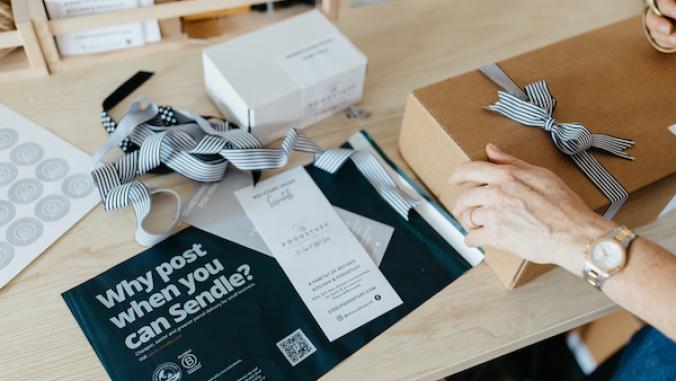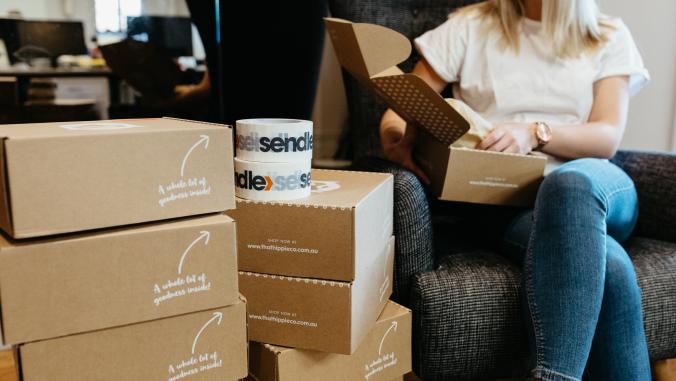This article is sponsored by Sendle.
When was the last time you thought about shipping? Most likely when eagerly awaiting an item, or you received a frustrating notification that your package has been delayed. It’s easy to overlook the shipping industry when people don’t know how parcels move from Point A to Point B.
When all goes well, it’s a system hiding in plain sight. The thrilling part happens after the delivery — the fun of unwrapping a package even when it’s not your birthday.
But if you think about it, a remarkable amount of behind-the-scenes effort moves each shipment. Say you live in St. Louis and sold a guitar case to someone in Cleveland. For $7 through a service such as Sendle, that guitar case will be picked up from your home, driven to a local depot, sorted, trucked, sorted, trucked, sorted and finally put on a truck or van and delivered to your buyer’s home — all in three days or less. That’s a lot happening for a little over $2 a day.
But if you’re still wondering, "Why should I care as long as I get my delivery?" Think this: Shipping plays a major role in two of the biggest issues of our time — climate change and inequality.
Part of why shipping matters is its scale. Every single day, millions of parcels are zipping across our world. These small, boxy ambassadors of e-commerce bliss aren't just tokens of our online shopping sprees; they represent something much bigger. Collectively, they are the backbone of our global economy.
For example, research finds that over 161 billion parcels were shipped globally in 2022, while that volume jumps to 256 billion packages to be shipped in 2027. By growing by leaps and bounds, the shipping industry could not be more relevant or pivotal than it is today. The way we ship isn’t just about moving goods. It’s about how our society chooses to operate. Every single person involved in parcel delivery carries decisions about our planet, our economy and our shared future.
According to the United States Environmental Protection Agency (EPA), transportation is one of the top five contributors to anthropogenic U.S. greenhouse gas (GHG) emissions. As a percentage of transportation, shipping and logistics produce 3 percent of global greenhouse gases; but this may grow by up to six times by 2050 as online shopping online becomes standard worldwide. It’s great if we all ride public transit or drive electric cars, but if we haven’t figured out clean shipping, we have not solved the problem.
There are shipping companies that minimize the carbon footprint of their deliveries. For example, Sendle doesn't operate its own fleet and add Sendle trucks to the road. Rather, Sendle taps into existing shipping providers and fills their vehicles to ensure every trip is as efficient as possible. With this model, we help our shipping partners make their routes more profitable, passing that savings along to our small business customers. We purchase high-quality carbon offsets to account for the remaining carbon emissions and address the impact of every Sendle parcel sent.
At Sendle, we know that shipping doesn’t have to cost the planet. Unfortunately, we’ve found that the industry largely doesn’t share in our vision — even though the path the world is on isn’t even good for the shipping industry from a purely economic standpoint. Why? Because the impacts of climate change are already here and can be felt throughout the industry.
The signs of climate change are insidious. They can cause delivery delays and service outages due to extreme weather events. Investments in decarbonization, such as switching to electric vehicle fleets, require funds, but they are the smarter business choice than the multi-billion dollar price tag of inaction. That’s why Sendle is committed to working with our partners to reach net zero emissions by cleaning up the carbon mess created by shipments and preventing it by transitioning away from fossil fuel-powered deliveries. But we realize that we can’t do it alone. As a result, Sendle has challenged its competitors to take accountability for their carbon footprints — with some success, which we’ll share below.
For example, we invented the Sendle sticker in Australia to offset a parcel no matter who delivers it. The Sendle sticker was part of an Australian initiative to offset Australia Post’s emissions and put pressure on the national postal service to go carbon neutral. We provided Sendle stickers for Australians to pop onto their Australia Post packages and we offset their emissions for them. Australia Post soon announced that it would deliver a subset of their parcels carbon-neutrally. It’s a start, but there’s more work to be done. You can do your part by challenging your shipping provider on how they account for their emissions, or by choosing one that is already using electric vehicles and offsetting emissions.
Once we tackle carbon output from shipping, we just unpack another problem. Most of us already intuited the environmental impact lingering behind frequent deliveries and the cardboard boxes piling up on our doorsteps. But what you might not realize is how much shipping contributes to inequality. Let’s start by looking at the shipping industry itself.
In most countries, shipping is dominated by a single player, essentially a functional monopoly, such as Australia Post or Canada Post. In the U.S., though, the shipping market is dominated by players such as FedEx and UPS. When you look at how these companies set their rates and services, one thing is clear: They pander primarily to their biggest customers. While keeping their largest customers happy makes sense as a business strategy, small businesses end up cross-subsidizing the very same big businesses they’re competing against.
Millions of small, home-operated, online retail businesses need simple, reliable, affordable and sustainable shipping.In fact, high shipping costs are the top reason for online cart abandonment. Large players subsidize shipping costs to get customers to check out. But when shippers charge small businesses twice as much as their preferred larger customers, small businesses can’t compete.
An innovative shipping model that is built specifically for small business such as Sendle’s brings together small business volumes to ensure they get better rates and access to shipping infrastructure that is otherwise only accessible to big businesses. Certified Benefit Corporations (B Corps) such as Sendle are not only accountable to shareholders. We are accountable to employees, the environment, investors and the community, not just shareholders. Innovative solutions such as Sendle level the playing field for small businesses. We envision a vibrant, bustling world where smaller companies can compete with (and win!) against industry giants.
It is evident that Sendle’s approach to package handling isn't just about logistics. It moves us close to an economy and world we want to live in, where smaller businesses can thrive. The shipping industry is tied directly to our collective ability to face pressing challenges. When we give a ship about sustainable building practices, we can address climate change and promote fairness to deliver a brighter future.
Learn more about sustainable shipping for small business at: sendle.com.




80e3.jpg)